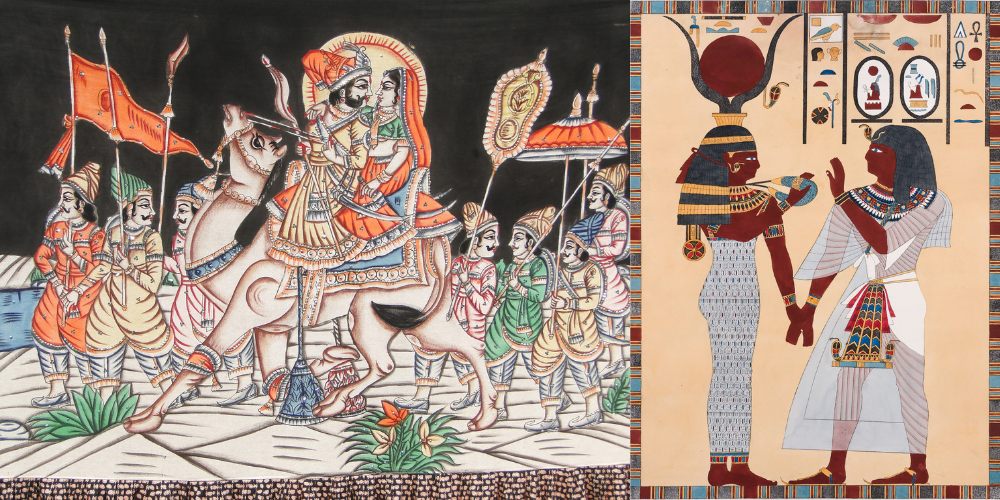An inexplicable combination of creative and communicative, illustration art has been a mainstay in humanity for centuries. Whether they be modern digital masterpieces or ancient cave paintings, illustrations have acted as potent visual narratives, enriching our understanding of the world around us and our imaginations within it.
This blog post explores the fascinating world of illustration art, including its history, diverse forms and techniques, and enduring relevance in today’s world.
A Journey Through Time: The Evolution of Illustration
The roots of illustration art can be traced back to the dawn of humanity. Early humans used rudimentary drawings to record their experiences, convey information, and express their beliefs. As civilisations developed, so did the art of illustration.
- Ancient Civilisations: Egyptian tombs were adorned with intricate hieroglyphics and vibrant murals depicting scenes from their daily lives and afterlife. The Greeks and Romans utilised illustrations for storytelling, mythology, and portraiture.
- Medieval Era: Painstakingly crafted by monks, illuminated manuscripts brought religious texts to life with ornate calligraphy and detailed illustrations. These works of art served not only as religious documents but also as historical records and cultural artifacts.
- Renaissance and Beyond: Renaissance and Following: The introduction of the printing press during the 15th century changed the nature of illustration art. As woodcuts and engravings allowed for the mass production of images, information and knowledge became available to the general population. Illustration was taking shape in ways that reflected the robust and powerful thought processes of the artists Albrecht Dürer, Leonardo da Vinci, and others.
- 19th Century: The Golden Age of Illustration flourished during the Victorian era. Advances in printing technology led to the rise of illustrated magazines and books, creating a demand for skilled illustrators. Artists like Arthur Rackham, Edmund Dulac, and Beatrix Potter captivated audiences with their enchanting illustrations for children’s literature and classic fairy tales.
- 20th Century: The 20th century witnessed a diversification of illustration styles. Art Nouveau, Art Deco, and Modernism influenced illustrators, leading to bold experimentation with form, colour, and composition. The rise of advertising and commercial art further expanded the scope of illustration, with artists like Norman Rockwell and J.C. Leyendecker creating iconic images that shaped popular culture.
- The Digital Age: With the advent of technology, illustration art has fundamentally transformed, toying with creative avenues and opening endless possibilities in the process. Thanks to software programs such as Adobe Photoshop and Illustrator, illustrators have been able to create stunning digital paintings, graphic designs, and 3D models. The internet has played a massive role in democratising the field since anyone can share work with a global audience and be a client globally with just a click of a button.
A Kaleidoscope of Styles: Exploring the Diversity of Illustration
Illustration art encompasses a wide range of styles, each with its unique characteristics and applications. Some of the most prominent styles include:
- Realistic Illustration: This style aims to depict subjects with accuracy and detail, capturing their likeness and essence. It is often used in scientific and medical contexts, as well as in portraiture and historical depictions.
- Cartoon Illustration: Characterised by exaggerated features, simplified shapes, and vibrant colours, cartoon illustrations are often used in comics, animation, and children’s books. They evoke humour, emotion, and a sense of playfulness.
- Line Art: This minimalist style focuses on the power of lines to create form and expression. Line art can be simple or intricate, and it is often used in editorial illustrations, book covers, and logo design.
- Graphic Illustration: This style combines graphic design and illustration elements and emphasises bold shapes, strong lines, and vibrant colours to create visually striking images. Graphic illustrations are commonly used in advertising, posters, and web design.
- Surreal Illustration: Drawing inspiration from dreams, fantasy, and the subconscious, surreal illustrations create fantastical and thought-provoking imagery. They often challenge conventional perspectives and explore themes of identity, imagination, and the human condition.
Tools of the Trade: Techniques and Materials in Illustration
Illustrators employ a variety of techniques and materials to bring their visions to life. Traditional methods include:
- Drawing: Pencils, charcoal, pastels, and ink are essential tools for illustrators, allowing them to create sketches, studies, and finished artwork.
- Painting: Watercolor, acrylic, and oil paints offer a wide range of possibilities for creating textured and vibrant illustrations.
- Printmaking: Techniques like etching, engraving, and lithography enable illustrators to produce multiple copies of their artwork.
Digital tools have expanded the illustrator’s arsenal, offering new avenues for creative expression:
- Digital Painting: Software like Photoshop and Procreate emulate traditional painting techniques, allowing artists to create realistic and expressive digital artwork.
- Vector Graphics: Programs like Illustrator enable illustrators to create scalable graphics using mathematical equations, resulting in clean, crisp lines and shapes.
- 3D Modeling: Software like Blender and Maya allows illustrators to create three-dimensional models and scenes, adding depth and realism to their work.
The Enduring Relevance of Illustration Art
In today\’s visually driven world, illustration art plays a vital role in entertainment, communication, and education.
- Visual Storytelling: Illustrations can take us to different worlds, stir emotions, and express abstract ideas clearly and compellingly. They are bedrock tools for storytelling in children’s books, graphic novels and animated movies.
- Information and Education: Images can break down information in a clear, appealing way that is useful for all learners. They are used in school books, infographics, and articles to explain concepts and obtain insights.
- Advertising and Marketing: In a crowded marketplace, illustrations can help brands stand out from their competition and connect with their target audience. They are used in advertising campaigns, product packaging, and social media marketing to create memorable and persuasive visuals.
- Self-Expression and Social Commentary: Illustration art provides a stage for artists to express their unique perspectives and engage with social and political issues. Illustrators can challenge norms, spark conversations, and inspire change through their work.
Conclusion
Illustration art is an evolving category that enthrals and inspires. Examples of illustrations are everywhere, from ancient paintings on cave walls to modern digital artworks. They have been used as tools of communication, education, and self-expression throughout history. Technology continues to progress, and with it, new creative opportunities; therefore, the art of illustration will continue to be imperative in shaping our visual landscape and expanding our vision of the world.
Disclaimer
This blog is for general information and education purposes only. Although the author has tried to provide a complete and accurate presentation of the information, no warranty, implied or express, is provided by the author in this regard. The content of this blog post is not based on professional advice and should not be used as an alternative to consultations with qualified professionals.


